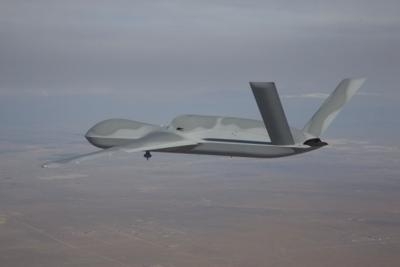Mon, Jun 20, 2016
Demonstrates U2-class Surveillance Capability From Significant Standoff Ranges
General Atomics Aeronautical Systems has announced the successful flight tests of Predator C Avenger, equipped with a MS-177 Electro-optical/Infrared (EO/IR) sensor manufactured by UTC Aerospace Systems.

MS-177, an advanced sensor in UTC's SYERS family of sensors, is a key component that supports GA-ASI's effort to equip Avenger with a long-range imaging capability. MS-177 is more technically advanced than the SYERS 2 flying on U-2 aircraft and also is significantly more affordable to manufacture. The sensor is a 7-band multi-spectral system that can be upgraded to a 10-band system to enhance target detection for maritime applications.
"Avenger and MS-177 deliver a game-changing capability that dramatically alters the Intelligence, Surveillance, and Reconnaissance [ISR] landscape," said Linden Blue, CEO, GA-ASI. "A MS-177-equipped Avenger provides a strategic ISR capability at a fraction of the cost of other ISR collecting platforms, offering high-resolution imagery from significant standoff ranges, thereby expanding the situational awareness of the warfighter greatly."
During government-funded testing, Avenger demonstrated its ability to collect high-resolution imagery of land-based and littoral objects with the MS-177 sensor at altitudes above 37,000 feet Mean Sea Level (MSL). A total of seven test flights occurred between January and February 2016 at Naval Air Weapons Station, China Lake, CA.
GA-ASI plans to begin flight testing of an Improved Avenger in October 2016, which will further enhance the operational capabilities of the MS-177. With an increased wingspan of 76 feet, Improved Avenger will extend the aircraft's already impressive endurance from 15 hours to 20 hours, thus increasing the utility of MS-177 over a longer period of time. Improved Avenger will provide an optimal balance of long loiter ISR and precision-strike capability, supporting a wide array of sensors and weapons payloads to perform high-speed, long-endurance, multi-mission ISR and ground support missions.
(Source: General Atomics news release. Image from file)
More News
Also: New SAF, Korean Air Buys 103 Boeings, Maryland SP Helo Rescue, OK AWOS Update Gulfstream Aerospace Corporation announced its first customer delivery of the all-new Gulfstream>[...]
"This is just an absolute win win win. If there is a rejected takeoff we now have the confidence that the arrestor system will ensure passenger and crew safety." Source: FAA Admini>[...]
Low Approach An approach over an airport or runway following an instrument approach or a VFR approach including the go-around maneuver where the pilot intentionally does not make c>[...]
Aero Linx: Historic Aircraft Association (HAA) The Historic Aircraft Association (HAA) was founded in 1979 with the aim of furthering the safe flying of historic aircraft in the UK>[...]
While Flying About 1,500 Ft Above Ground Level, A Large Bird Struck The Right Side Of The Airplane Analysis: The pilot reported that while flying about 1,500 ft above ground level,>[...]
 Airborne 08.29.25: G800 Delivery, Alaska F-35 Crash, USCG-RCAF Medevac
Airborne 08.29.25: G800 Delivery, Alaska F-35 Crash, USCG-RCAF Medevac Aero-News: Quote of the Day (08.30.25)
Aero-News: Quote of the Day (08.30.25) ANN's Daily Aero-Term (08.30.25): Low Approach
ANN's Daily Aero-Term (08.30.25): Low Approach ANN's Daily Aero-Linx (08.30.25)
ANN's Daily Aero-Linx (08.30.25) NTSB Final Report: Excalibur Excalibur
NTSB Final Report: Excalibur Excalibur



